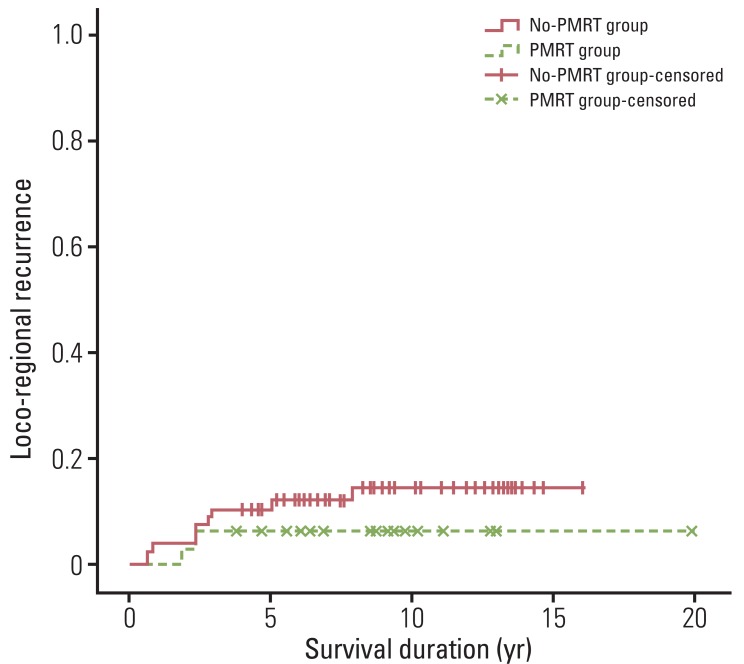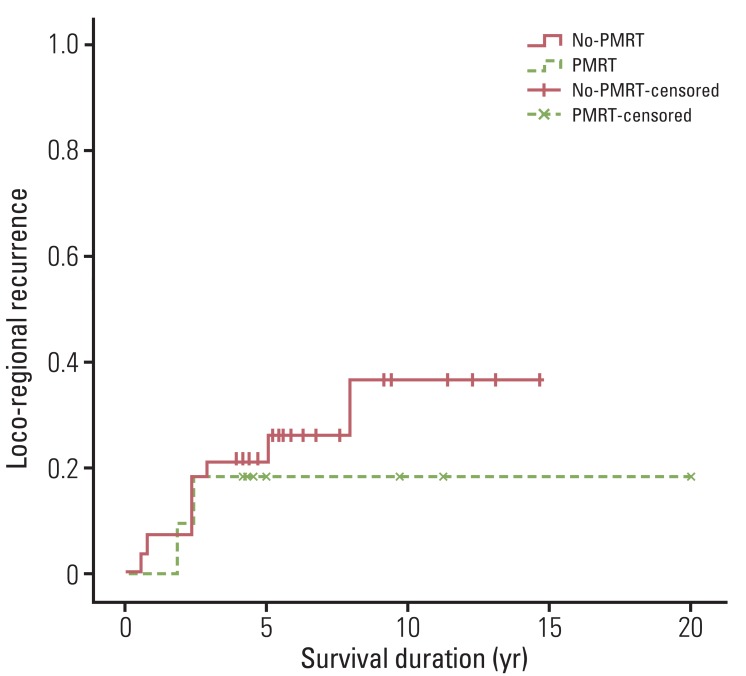Cancer Res Treat.
2013 Jun;45(2):103-111.
Which Patients Might Benefit from Postmastectomy Radiotherapy in Breast Cancer Patients with T1-2 Tumor and 1-3 Axillary Lymph Nodes Metastasis?
- Affiliations
-
- 1Department of Radiation Oncology, Kyung Hee University Medical Center, Kyung Hee University School of Medicine, Seoul, Korea. anjdixn@naver.com
Abstract
- PURPOSE
This study compared the clinical outcomes of T1-2N1 breast cancer patients with and without postmastectomy radiotherapy (PMRT). Risk factors for loco-regional recurrence (LRR) were identified in order to define a subgroup of patients who might benefit from PMRT.
MATERIALS AND METHODS
Of 110 T1-2N1 breast cancer patients who underwent mastectomy from January 1994 through December 2009, 32 patients underwent PMRT and 78 patients did not. Treatment outcomes and risk factors for LRR were analyzed.
RESULTS
The 5- and 10-year LRR rates were both 6.2% in the PMRT group, and 10.4% and 14.6% in the no-PMRT group (p=0.336). In addition, no significant differences in distant metastasis-free survival (DMFS) or overall survival (OS) were observed between patients receiving and not receiving PMRT. In multivariate analysis, factors associated with higher LRR rates included grade 3 disease, extracapsular extension (ECE), and triple negative subtype. Patients who had one or more risk factors for LRR were defined as a high-risk patient group. In the high-risk group, both 5- and 10-year LRR rates for patients who underwent PMRT was 18.2%, and LRR rates of 21.4% at five years and 36.6% at 10 years were observed for patients who did not undergo PMRT (p=0.069).
CONCLUSION
PMRT in T1-2N1 breast cancer patients should be considered according to several prognostic factors in addition to T and N stage. Findings of our study indicated that PMRT did not improve LRR, DMFS, or OS in T1-2N1 breast cancer patients. However, in a subgroup of patients with grade 3 disease, ECE, or triple negative subtype, PMRT might be beneficial.
Keyword
MeSH Terms
Figure
Reference
-
1. Ragaz J, Jackson SM, Le N, Plenderleith IH, Spinelli JJ, Basco VE, et al. Adjuvant radiotherapy and chemotherapy in node-positive premenopausal women with breast cancer. N Engl J Med. 1997; 337:956–962. PMID: 9309100.
Article2. Overgaard M, Hansen PS, Overgaard J, Rose C, Andersson M, Bach F, et al. Postoperative radiotherapy in high-risk premenopausal women with breast cancer who receive adjuvant chemotherapy. Danish Breast Cancer Cooperative Group 82b Trial. N Engl J Med. 1997; 337:949–955. PMID: 9395428.3. Overgaard M, Jensen MB, Overgaard J, Hansen PS, Rose C, Andersson M, et al. Postoperative radiotherapy in high-risk postmenopausal breast-cancer patients given adjuvant tamoxifen: Danish Breast Cancer Cooperative Group DBCG 82c randomised trial. Lancet. 1999; 353:1641–1648. PMID: 10335782.
Article4. Whelan TJ, Julian J, Wright J, Jadad AR, Levine ML. Does locoregional radiation therapy improve survival in breast cancer? A meta-analysis. J Clin Oncol. 2000; 18:1220–1229. PMID: 10715291.
Article5. Recht A, Edge SB, Solin LJ, Robinson DS, Estabrook A, Fine RE, et al. Postmastectomy radiotherapy: clinical practice guidelines of the American Society of Clinical Oncology. J Clin Oncol. 2001; 19:1539–1569. PMID: 11230499.
Article6. Truong PT, Olivotto IA, Whelan TJ, Levine M. Steering Committee on Clinical Practice Guidelines for the Care and Treatment of Breast Cancer. Clinical practice guidelines for the care and treatment of breast cancer: 16. Locoregional post-mastectomy radiotherapy. CMAJ. 2004; 170:1263–1273. PMID: 15078851.
Article7. Taylor ME, Haffty BG, Rabinovitch R, Arthur DW, Halberg FE, Strom EA, et al. ACR appropriateness criteria on postmastectomy radiotherapy expert panel on radiation oncology-breast. Int J Radiat Oncol Biol Phys. 2009; 73:997–1002. PMID: 19251087.8. Wallgren A, Bonetti M, Gelber RD, Goldhirsch A, Castiglione-Gertsch M, Holmberg SB, et al. Risk factors for locoregional recurrence among breast cancer patients: results from International Breast Cancer Study Group Trials I through VII. J Clin Oncol. 2003; 21:1205–1213. PMID: 12663706.
Article9. Sorlie T, Perou CM, Tibshirani R, Aas T, Geisler S, John-sen H, et al. Gene expression patterns of breast carcinomas distinguish tumor subclasses with clinical implications. Proc Natl Acad Sci U S A. 2001; 98:10869–10874. PMID: 11553815.
Article10. Trovo M, Durofil E, Polesel J, Roncadin M, Perin T, Mileto M, et al. Locoregional failure in early-stage breast cancer patients treated with radical mastectomy and adjuvant systemic therapy: which patients benefit from postmastectomy irradiation? Int J Radiat Oncol Biol Phys. 2012; 83:e153–e157. PMID: 22386375.
Article11. Truong PT, Olivotto IA, Kader HA, Panades M, Speers CH, Berthelet E. Selecting breast cancer patients with T1-T2 tumors and one to three positive axillary nodes at high postmastectomy locoregional recurrence risk for adjuvant radiotherapy. Int J Radiat Oncol Biol Phys. 2005; 61:1337–1347. PMID: 15817335.
Article12. Ragaz J, Olivotto IA, Spinelli JJ, Phillips N, Jackson SM, Wilson KS, et al. Locoregional radiation therapy in patients with high-risk breast cancer receiving adjuvant chemotherapy: 20-year results of the British Columbia randomized trial. J Natl Cancer Inst. 2005; 97:116–126. PMID: 15657341.
Article13. Overgaard M, Nielsen HM, Overgaard J. Is the benefit of postmastectomy irradiation limited to patients with four or more positive nodes, as recommended in international consensus reports? A subgroup analysis of the DBCG 82 b&c randomized trials. Radiother Oncol. 2007; 82:247–253. PMID: 17306393.14. Marks LB, Zeng J, Prosnitz LR. One to three versus four or more positive nodes and postmastectomy radiotherapy: time to end the debate. J Clin Oncol. 2008; 26:2075–2077. PMID: 18445836.
Article15. Cosar R, Uzal C, Tokatli F, Denizli B, Saynak M, Turan N, et al. Postmastectomy irradiation in breast in breast cancer patients with T1-2 and 1-3 positive axillary lymph nodes: is there a role for radiation therapy? Radiat Oncol. 2011; 6:28. PMID: 21450076.
Article16. Smith BD, Smith GL, Haffty BG. Postmastectomy radiation and mortality in women with T1-2 node-positive breast cancer. J Clin Oncol. 2005; 23:1409–1419. PMID: 15735117.
Article17. Fowble B. Postmastectomy radiation in patients with one to three positive axillary nodes receiving adjuvant chemotherapy: an unresolved issue. Semin Radiat Oncol. 1999; 9:230–240. PMID: 10378961.
Article18. Fernando IN. The role of radiotherapy in patients undergoing mastectomy for carcinoma of the breast. Clin Oncol (R Coll Radiol). 2000; 12:158–165. PMID: 10942332.
Article19. Pierce LJ. Treatment guidelines and techniques in delivery of postmastectomy radiotherapy in management of operable breast cancer. J Natl Cancer Inst Monogr. 2001; 30:117–124. PMID: 11773304.
Article20. Kunkler IH, Canney P, van Tienhoven G, Russell NS. MRC/EORTC (BIG 2-04) SUPREMO Trial Management Group. Elucidating the role of chest wall irradiation in 'intermediate-risk' breast cancer: the MRC/EORTC SUPREMO trial. Clin Oncol (R Coll Radiol). 2008; 20:31–34. PMID: 18345543.
Article21. Sotiriou C, Wirapati P, Loi S, Harris A, Fox S, Smeds J, et al. Gene expression profiling in breast cancer: understanding the molecular basis of histologic grade to improve prognosis. J Natl Cancer Inst. 2006; 98:262–272. PMID: 16478745.
Article22. Kreike B, Halfwerk H, Kristel P, Glas A, Peterse H, Bartelink H, et al. Gene expression profiles of primary breast carcinomas from patients at high risk for local recurrence after breast-conserving therapy. Clin Cancer Res. 2006; 12:5705–5712. PMID: 17020974.
Article23. Duraker N, Demir D, Bati B, Yilmaz BD, Bati Y, Caynak ZC, et al. Survival benefit of post-mastectomy radiotherapy in breast carcinoma patients with T1-2 tumor and 1-3 axillary lymph node(s) metastasis. Jpn J Clin Oncol. 2012; 42:601–608. PMID: 22511807.
Article24. Sotiriou C, Neo SY, McShane LM, Korn EL, Long PM, Jazaeri A, et al. Breast cancer classification and prognosis based on gene expression profiles from a population-based study. Proc Natl Acad Sci U S A. 2003; 100:10393–10398. PMID: 12917485.
Article25. Nguyen PL, Taghian AG, Katz MS, Niemierko A, Abi Raad RF, Boon WL, et al. Breast cancer subtype approximated by estrogen receptor, progesterone receptor, and HER-2 is associated with local and distant recurrence after breast-conserving therapy. J Clin Oncol. 2008; 26:2373–2378. PMID: 18413639.
Article
- Full Text Links
- Actions
-
Cited
- CITED
-
- Close
- Share
- Similar articles
-
- Factors related with Axillary Lymph Nodes Metastases in T1 invasive ductal carcinomas of the Breast
- Postmastectomy Radiation Therapy in Patients With Minimally Involved Lymph Nodes: A Review of the Current Data and Future Directions
- Incidence of Axillary Lymph Node Metastases in T1 Breast Cancer
- The Accuracy of Axillary Ultrasonography for Patients with T1-2 Breast Cancers
- Incidence of Axillary Lymph Node Metastases in T1 Breast Cancer






